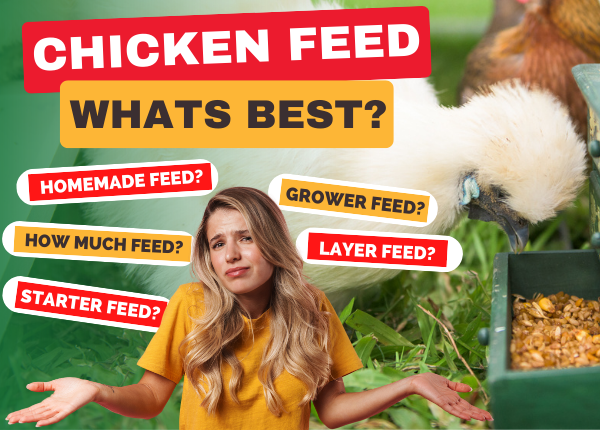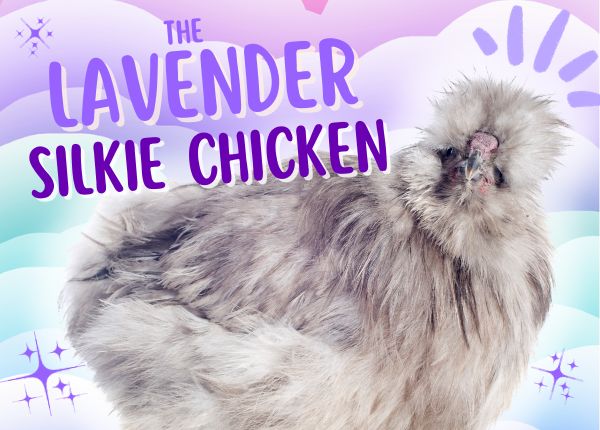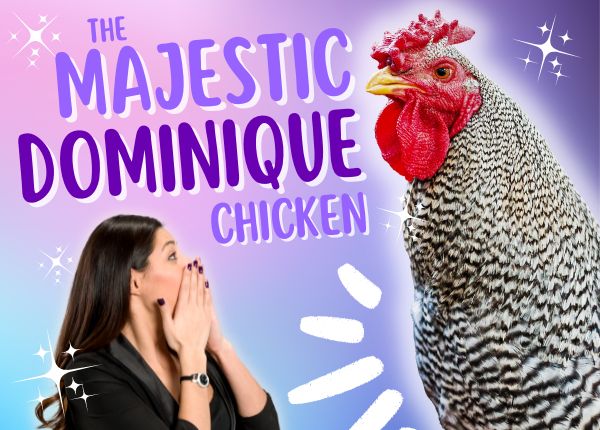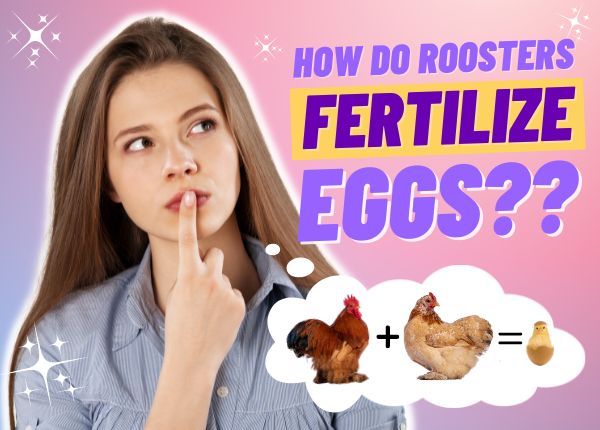
Chickens LIVE for their food! The sight of a yummy treat😋 will make your chicken go absolutely pecking crazy!
You know what they say about the way to a man’s heart? To earn the love of your chickens, aim for their gullet.
Gone are their days of surviving on scraps. When our great grandparents kept chickens, they served kitchen waste with a side of bugs, and those birds did just fine. These days, we treat our chickens like family (or royalty) and we’re a bit more clued up on nutrition (no offense, Nan).
It’s one big cycle: you are what you eat, and so are your chickens, and you’ll be eating their eggs, so feed them well!
Healthy hens lay the most yummy, scrummy, get-in-my-tummy eggs. Getting your hen’s diet just right keeps them happy, and their egg-yolks deliciously bright.
We love our chickens! All we really want is happy, healthy hens with bright eyes and bushy tail feathers. So, let’s get to work!
You’ll need to know your nuggets from your manganese to dish up an im-peck-able dish that your ladies (and gents) will love you for.
Let’s get started. Grubs up!
Skip to Your Favourite Subject Here:
- What Do Chickens Eat?
- What Different Types of Chicken Feed Are there?
- What Varieties of Chicken Feed Are there?
- What Food Is Best Feed for Chickens?
- How Much Should I Feed My Chickens?
- How Much Do Chickens Eat?
- A Handy Guide to Chicken Feed Consumption
- Do Chickens Need More Food in The Winter?
- When To Feed Your Chickens
- What Is Free Feeding?
- Chicken Feed Milestones
- What To Feed a Hatchling
- What to Feed a Baby Chick
- How To Feed a Baby Chick
- What’s in Starter Feed?
- What To Feed a Pullet
- What’s in Grower Feed?
- What to Feed Laying Hens
- What’s in Layer Feed?
- Will Feeding My Pullet Layer Food Speed up her Laying?
- What to Feed a Broiler Chicken
- What To Feed Roosters?
- How Do I Know My Chicken’s Diet is Right for Them?
- Which Foods Are Dangerous for Chickens?
- How To Store Chicken Feed
- Which Chicken Feeders Are Best?
- Feeding a Mixed Flock
- Can Chickens Have Treats?
- What Do Chickens Like to Snack On?
- Can I Buy Ready-Made Chicken Treats?
- What is Chicken Scratch?
- Chicken Dietary Supplements
- How Much Water Do Chickens Need?
- Why Do Chickens Need Grit?
- Do Free Range Chickens Need Grit?
- Which Chicken Grit is Best?
- Why Do Chickens Need Oyster Shell?
- Expert Diet Tips from Chickenpedia
- DIY Chicken Feed
- Can I Make My own Chicken Feed?
What Do Chickens Eat?
Not KFC, that’s for sure! Chickens need a mixed diet including high-quality chicken feed, healthy treats, and water. The type of chicken feed that they need will vary as they grow. You might shed a tear when your pullet eats her first dish of layer feed. They grow up so fast! (crying emoji)
What Different Types of Chicken Feed Are there?
There are tonnes of chicken feed products on the market, which can make it all feel a little daunting. Find a great quality feed that suits their needs and your budget, but accept that everyone, and every hen, has a taste for something different. You may find Judy just prefers a certain brand or texture.
There are different ranges of chicken feed available to suit different ages of chicken. This isn’t a gimmick! They each have a different percentage of protein and calcium in them and feeding the wrong range of feed can be detrimental to your chicken’s health. Think of it just like babies as they grow, they progress from breast milk, to solids, and so forth. Chickens are the same, but at a rapid speed.
Chicken Feed Types Include:
All you need to know if what age your chickens are, so you can purchase (or make) the right kind of feed.
- Starter Feed for chicks🐣
- Grower Feed for pullets
- Finisher/Developer Feeds for female pullets due to lay soon
- Layer Feed for…well, you get it
- All flock Feed for mixed poultry flocks
- Homemade chicken feed which can be made bespoke for your own flock’s needs
What Varieties of Chicken Feed Are there?
Staged chicken feed also comes in different varieties, in different forms, and with different additives:
Medicated Feed is treated with a coccidiostat. It can help chicks fight off potential coccidian protozoa infections.
Organic Feed is free of GMOs such as pesticides, hormones, and antibiotics.
Vegetarian Feed is free of meat products. Whilst chickens are omnivores, you may not like the idea of them chowing down on bone meal, dried blood, and other slaughterhouse waste.
Pellets are compacted feed that is easy to measure and eat which means less mess and less waste.
Crumbles are just small pellets that are easier for chicks to eat.
Mash is unprocessed chicken feed. It’s very fine textured, almost powder-like, and can be used for chicks or picky adults and be served dry or wet.
Fermented feed is any type of chicken feed that has been mixed with water and left to ferment.
Eggspert Advice: “The fermentation process increases vitamins and protein content, creates more easily digestible feed, improves the quality of eggs and even tends to generate firmer droppings.”(Chickenpedia Nutrition Course)

What Food Is Best Feed for Chickens?
Homemade or store-bought, it doesn’t matter. What matters most is what makes up your chicken’s feed. So long as you match the content of their feed (especially protein and calcium levels) to the stage in your feathery friend’s life, you’re doing great!
Stage-specific chicken feeds are a safer bet than all flock feeds, which contain an average protein level for chickens, ducks, and geese for example: around 16% - 22%. It’s not going to suit chicks or laying hens, but you could pullet off for pullets!
Good quality layer feed will include extra vitamins like vitamin A, E, D3, and B12, and trace minerals like phosphorus and copper sulfate. Some even contain a dose of omega-3, which does little for the hens, but makes their eggs healthier to eat.
How Much Should I Feed My Chickens?
Chickens will tell you how much they want to eat. It’s best to feed them more than you think they’ll need, and you’ll soon be able to judge their appetites by their leftovers. Chickens rarely overeat, and obesity is only an issue if they’re broiler breeds or unable to exercise.
How Much Do Chickens Eat?
As a very rough guide, chickens are said to eat half a cup or ¼ lb of feed per day.
The amount your chickens will gobble up will depend on their age and activity levels (free ranging is so important to their diet, and your egg quality), but most of all their breed. A Jersey Giant rooster will need much bigger portions than a Silkie bantam pullet.
Being able to eggs-timate how much feed to buy, or to make, can really help with budgeting.
A Handy Guide to Chicken Feed Consumption
- Chicks 1-ounce starter feed a day
- Pullets 2-3 ounces grower feed per day
- Laying Hens 3.5 - 4 ounces layer feed a day
- Roosters 6-8 ounces a day
- Bantams 1-1.5 ounces feed per day

Do Chickens Need More Food in The Winter?
Chickens don’t need a change to their diet in the winter, but their appetites may increase a little to gain more protein and carbohydrates to lay down some fat cells and keep those booties toasty warm. They will benefit from a high protein diet during their moult though.
When To Feed Your Chickens
Feed chickens 2-3 times a day if you want to control your chicken’s feed times. Mornings and afternoons are perfect to start and end your day with a flock who are very happy to see you (or what’s in the bucket!) Feeding your chickens too late in the evening means predators are about. They may be too anxious to eat, or just ready for bed. Ideally use a feeder that is predator proof, which they can access all day if needed, while the roam around free ranging.
What Is Free Feeding?
Free feeding is the poultry version of an all-you-can-eat, and it’s the preferred feeding method for most keepers. It just means that your darlings can dine as and when it suits them, they won’t go hungry, and you don’t need to panic if you can’t make it home for teatime.
CHICKEN FEED MILESTONES
What To Feed a Hatchling
Hatchlings need starter crumble and water. Nothing more. Feeding hatchlings is so egg-citing. Watching them bumble around looking for their first scratch is super sweet. No treats to begin with though, they’ll get a sweet tooth.
What to Feed a Baby Chick
For the first hour don’t feed your hatchlings at all, just offer them water. Baby chicks can be fed starter feed up until 6 weeks old.
How To Feed a Baby Chick
Whilst instinct should kick in, occasionally it doesn’t. This is where learning how to care for chicks can be lifesaving.
“Your chicks should find their way to the feeder by instinct, but if they don’t…”(Chickenpedia Nutrition Course)
What’s in Starter Feed?
Starter feed is a 20% protein mix that gives chicks the oomph they need to grow up quickly. They’ll change a lot in the first 6 weeks of their lives, and they need extra protein to help them thrive.
What To Feed a Pullet
You should start to feed your chicks grower feed at about 6 weeks of age. Once your babies hit 6 weeks their personalities and bodies will be changing rapidly. So will their diet.
Pullets are poultry teenagers. Good cluck!
What’s in Grower Feed?
Grower feeds contain slightly lower protein ratios than starter feeds: around 16-18%.
What to Feed Laying Hens
Once your pullet pops out that first egg, she’s all grown up (time flies, hey!) Laying hens need a different diet than pullets. Their bodies are performing some cracking tricks, but that requires a very healthy diet.
Graduating from grower feed to layer feed is best done gradually, as a change in diet can give even the hardiest hen a touch of the runs.
What’s in Layer Feed?
Layer feed contains calcium, manganese, and various other nutrients essential for egg development and healthy hens. They also contain a smidge less protein than grower feeds: around 15-18%.
Will Feeding My Pullet Layer Food Speed up her Laying?
Don’t be tempted to switch your pullet to layer feed until she’s ready. She’ll let you know when by laying her very first egg for you. Big day!
Feeding pullets layer feed before they start to lay won’t speed things up, that’s not how this works, and the higher level of calcium can be detrimental. There are some finisher or developer feeds that are a safe halfway house, but they’re not necessary.
MORE CHICKEN FEED FAQs ANSWERED
What to Feed a Broiler Chicken
Meat birds, or broilers, are bred for their speedy growth spurts. This means they need more feed and lots of protein to help them grow up big and strong…and fast!
Broiler starter feed has 22-24% protein, and whilst other stages of broiler feed are available, most keepers agree you can stick to the same feed for their short life span. This is all they’ll need from their first to their final dish.
Most chicken keepers free feed their meat birds for 2 to 3 weeks and then free feed for one day and leave without feed for the next, and so on until they are ready to be dispatched (I’m not a fan of that word, but you know what I mean!)
What To Feed Roosters?
Roosters do best on grower feed for their adult years as they need more protein but less calcium than laying hens.
Roosters will be okay if they take a sneaky bite of layer feed, but don’t add any extra calcium to the feed if you know your roo prefers to dine with the Mrs.
How Do I Know My Chicken’s Diet is Right for Them?
There are lots of signs of malnutrition in chickens. Make sure you know what to look for!
Chickenpedia compiled this go-to guide for malnourishment symptoms using research from the experts at the University of Kentucky’s College of Agriculture, Food and Environment:
- They may look unkempt with ruffled feathers
- They may lay fewer eggs than usual
- Their eggs may be malformed or have shells that crack or break easily
- They may be uncoordinated or have an unsteady gait
- They may have a blue comb (vitamin B1 deficiency)
- They may have a lowered body temperature
- They may seem thin, weak, or even emaciated
- They may have dry, harsh skin
- They may have poor growth or seem stunted

Which Foods Are Dangerous for Chickens?
There are some foods to avoid with chickens. Some result in intolerances, and others are potentially toxic. If you needed an excuse not to share your chocolate, however much they peck at your ankles, then here it is…
- Consider your chicken ‘dairy free’. Whilst most chickens can handle dairy, it can be toxic for others.
- Dog or cat food is far too high in protein for chickens. Don’t do it.
- Avocado (the flesh can be eaten in moderation, but never ever give them the peel or stone)
- Dried or raw beans
- Anything moldy — including their usual feed once it looks like it’s gone off (for example if it wasn’t stored correctly)
- Green potatoes
- Green tomatoes — or tomato plants in general
- Onion - onion can be toxic and impact egg production
- Eggplants/Brinjals
- Salty food
- Rice
- The starch in raw potato peel can cause bloat, so don’t overdo it on the table scraps.

How To Store Chicken Feed
Chicken feed has a shelf life of 3-6 months depending on how well it’s stored. The best way to store it is in cool, but not cold, sealed containers. Metal trash cans or plastic tubs will work great, just make sure they aren’t kept in direct sunlight, or the feed will sweat and turn moldy.
If you have a large flock, and enough space, pop down to the skip and pick up a faulty chest freezer. They’re perfect for storing feed kept in an outhouse, and they don’t need to work for this job!
If you’re making your chicken feed, think about storage before making your batches.
Which Chicken Feeders Are Best?
A good chicken feeder isn’t a treat for your chickens - they could not give two hoots about where they dine - they’re a treat for you!
A good feeder means less mess, less waste, and less dressing-gown garden dashes.
Gravity feeders can be filled so that chickens can free feed, and they’re better still if you can hang them off the ground to avoid chickens trampling or pooping in their dinner. Yeah. They would!
Automated chicken feeders release feed for chickens at intervals, which means coops are less attractive to rodents, and feed is less likely to get wet or spoiled.
Heated waterers are the bomb when it comes to winter weather. You don’t have to layer up to tackle frozen waterers when the weather is horrid.
Feeding a Mixed Flock
Families come in all shapes and sizes, and so do chicken flocks. Just as it’s sometimes hard to prepare a meal for the whole family, feeding mixed flocks can need a little savvy prep work too.
If your flock has laying hens and roosters, or pullets and bantams, or even chickens and ducks, then you’ll need to tend to each bird’s dietary requirements. Feeding your mixed flock the same feed may be detrimental to some of your chickens.
If you have a flock of chickens and other poultry then all flock feed is fine, so long as you are keeping them all for meat, not for eggs or as pets. Flock feed is high in protein and low in calcium, so you will have beefy birds with weak eggs that are as useless as a chocolate teapot.
If you have pullets or roosters in with laying hens you should offer grower feed with additional calcium supplements separately, so you don’t risk a calcium overdose in chickens who don’t need it. Chickens that don’t need the extra calcium hit won’t bother with it.
If mama hen is raising her brood, she’ll be fine to share their starter feed. Whilst her focus is her new babies, she won’t be planning any more eggs for a while. She might even give you the death stare if you suggest it.
“It's a good idea to provide her with a bowl of eggshell or oyster shell on the side though, so she can start building up her calcium stores to prepare to begin laying eggs as soon as the chicks are on their own (around five weeks old). “ (Fresh Eggs Daily)
As well as the dietary needs of your chickens, you’ll need to consider their temperaments too. If little bantams or less bossy birds are likely to be bullied by your larger ladies or cocky cockerels, then place multiple feeders around the coop so everyone can enjoy their feed in peace.
CHICKEN TWEATS!
Can Chickens Have Treats?
If chickens could talk, you would open the door to a chorus of…
“Can I have a snack?”, “Snack Please”, “Just one more, I’m Staaaarving”, “That was tiny”, “Hers was bigger than mine!”
Snacks are the highlight of your hen’s day - so absolutely - treat your feathery friends! Snacks need to be given in moderation as sugary snacks can lead to obesity and cause complications with laying.
You know the drill – a moment on the lips (beak) a lifetime on the hips.
Make sure that your chicken’s diet is made up of 10% snacks and 90% feed. Maybe 20% on their birthday.
What Do Chickens Like to Snack On?
Here are some ideas for healthy snacks that your poultry-pal will adore you for:
- Blueberries
- Blackberries
- Mealworms
- Bird Seed
- Grapes
- Watermelon
- Raisins
- Corn
- Sunflower Seeds
- Table scraps
- Ice Treats

Can I Buy Ready-Made Chicken Treats?
If you’re a fan of a snack box, you can purchase poultry-specific treats. Some ideas include:
- Chicken Scratch
- Sunflower Seed Crusts (poultry granola bars)
- Oatmeal raisin treats
- Oven-baked chicken feed bites
- Vita-Bugs (a vitamin-enriched cricket treat)
What is Chicken Scratch?
Chicken scratch is a blend of entertainment and snacks. They usually consist of cracked, rolled, or whole grains such as corn🌽, barley, oats, or wheat. Scratch is low in protein, it’s a treat. Scatter and watch as your delighted Delawares peck around feverishly.
CHICKEN DIETARY SUPPLEMENTS
All chickens need grit and water in addition to food. If they’re not eating anything other than purpose-made chicken feed, they can manage without the grit (because it’s in it)…but never without water!
Laying hens need calcium, and if their chicken feed isn’t top of the crops, then they might need eggs-tra helpings. Calcium supplements like Oyster shell or Limestone are popular choices.
How Much Water Do Chickens Need?
It’s thirsty work looking so fabulous. Chickens will get through two to three times as much water as they do food. One quart of water for every four chickens should see your chickens through an average day, but not a hot one! Check out my Homemade Chicken Feed blog for homemade icy treat ideas!
Why Do Chickens Need Grit?
Grit does for chickens what teeth do for humans. Grit is an essential dietary supplement for chickens eating anything other than manufactured feed. In chickens, their food is passed through their gullet, where it’s mixed with grit (in whatever form it takes) to grind the food down and release the nutrients.
Do Free Range Chickens Need Grit?
Free-range chickens will forage for grit. They don’t need anything specific or spectacular, even a spot of soil on a leaf or a grain of sand will do the job. If they’re pecking at nature’s landscape, they’re fine!
Which Chicken Grit is Best?
If your chickens can’t free-range, and you need to add grit to their diet, then granite and cherry stone are two recommended grits.
Why Do Chickens Need Oyster Shells?
Oyster shells are a great way to feed laying hens eggs-tra calcium. If mama hens don’t get enough calcium, they’ll take it from their own body to facilitate egg production, leading to potential fractures. Talk about doing anything for your kids!
For a flock of laying hens add 2 pounds of the shell to every 100 pounds of complete layer feed.
If you have a mixed flock, make sure you offer the calcium supplement separately, in another dish or feeder. Too much calcium for pullets or roosters can be dangerous.
Chickenpedia’s nutrition course is the one catering course you really should consume!
Its a quick, easy, digestible course that will kit you out with table-service tools you won’t want to miss out on. Here are just a few of their food-supplement suggestions to get you started…
“Did you know that eggs — especially egg yolks can be a great boost for your chicks? Scramble some eggs (and add a touch of fresh garlic for an extra boost) and serve it up along with their starter crumble for a yummy, immune-boosting meal.” (Chickenpedia’s Chicken Nutrition Course)
“Add apple cider vinegar (ACV) to your chickens’ water to aid with digestion and help keep intestinal worms under control.”(Chickenpedia’s Chicken Nutrition Course)
“Marigold Extract will make the egg yolks a wonderful deep shade of gold”(Chickenpedia’s Chicken Nutrition Course)
“Garlic has many health benefits and small amounts of crushed garlic added to your chickens’ feed can help to give your chooks’ immune system a boost while also keeping their worm load in check.” (Chickenpedia’s Chicken Nutrition Course)
DIY CHICKEN FEED
Can I Make My Own Chicken Feed?
DI why not? Making your chicken feeds is a great way of reducing costs and controlling exactly what your babies eat.
What better way to show someone you love them than preparing their meals?
It doesn’t have to be as time-consuming as you might fear unless you want to practice your culinary creativity and serve them up a spectacular spread.
Easy DIY Chicken Feed – Cluck Here and Get Cracking!
If you don’t have the time (or the inclination) to make your chicken feed, don’t feel bad. Commercial foods offer a great range, and you can still care for your chickens by researching the right products for their needs. I’d recommend the Chickenpedia Chicken nutrition course to get clued up on clucky catering before hitting the stores.
I don’t want to overegg this point but knowing the crack when it comes to chicken feed can be – quite literally - life saving for your poultry pals.
Check out Chickenpedia’s Nutrition Course They will teach you more than what I have touched on here. Most chicken health issues could have been avoided if the correct knowledge was had – and the best part is, it’s easy with their chicken-keeping courses. Check them out now and see how your chickens thrive!!












Leave a comment (all fields required)